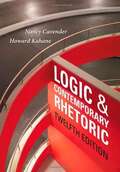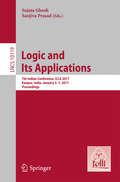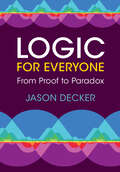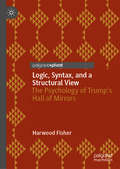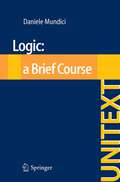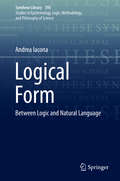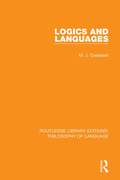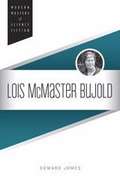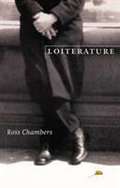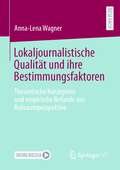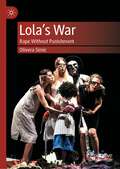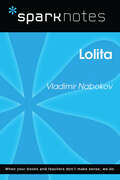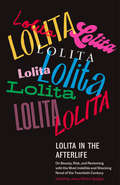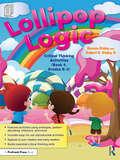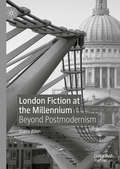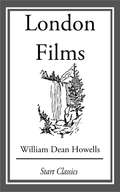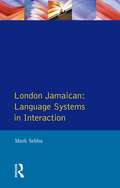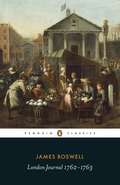- Table View
- List View
Logic and Contemporary Rhetoric: The Use of Reason in Everyday Life
by Nancy M. Cavender Howard KahaneThis classic text, first published in 1971, has introduced tens of thousands of students to sound reasoning using a wealth of current, relevant, and stimulating examples all put together and explained in Howard Kahane's uniquely witty and invigorating writing style. Long the choice of instructors who want to "keep students interested", LOGIC AND CONTEMPORARY RHETORIC combines examples from TV, newspapers, magazines, advertisements, and, in typical Kahanian fashion, our nation¹s political dialogue. The text not only brings the concepts alive for students, but puts critical thinking skills into a context that students will retain and use throughout their lives. This is a book you can actually count on students to read.
Logic and Its Applications
by Sanjiva Prasad Sujata GhoshThis book collects the refereed proceedings of the 7th Indian Conference on Logic and Its Applications, ICLA 2017, held in Mumbai, India, in January 2017. The volume contains 13 full revised papers along with 4 invited talks presented at the conference. The aim of this conference series is to bring together researchers from a wide variety of fields in which formal logic plays a significant role. Areas of interest include mathematical and philosophical logic, computer science logic, foundations and philosophy of mathematics and the sciences, use of formal logic in areas of theoretical computer science and artificial intelligence, logic and linguistics, and the relationship between logic and other branches of knowledge. Of special interest are studies in systems of logic in the Indian tradition, and historical research on logic.
Logic for Everyone: From Proof to Paradox
by Jason DeckerA rigorous, yet accessible and entertaining introduction to the field of logic, this book provides students with a unique insight into logic as a living field and how it connects to other fields of inquiry including philosophy, computer science, linguistics, and mathematics. With no background knowledge needed, students are introduced to a critical examination of 'classical logic', and the technical issues and paradoxes that may be encountered. Each chapter includes key pedagogical features such as marginal notes, definitions, chapter summaries and practice exercises. Arguments are backed up by authentic examples of logic within natural languages and everyday life. The flexible chapter structure allows instructors to tailor their teaching for either a one-semester or two-semester course, according to their students' needs and knowledge. Online resources include a companion website featuring further readings, class handouts, LaTeX resources, along with an Online Proof Evaluator allowing students to get real-time feedback.
Logic, Syntax, and a Structural View: The Psychology of Trump's Hall of Mirrors
by Harwood FisherThis book presents a new structural approach to the psychology of the person, inspired by Kenneth Colby’s computer-generated simulation, PARRY. The simulation was of a paranoid psychological state, represented in forms of the person's logic and syntax, as these would be evidenced in personal communication. Harwood Fisher uses a Structural View to highlight similarities in the logical form of the linguistic representations of Donald Trump, his avid followers (“Trumpers”), and the paranoid—referred to as “The Trio.” He demonstrates how the Structural View forms a series of logical and schematic patterns, similar to the way that content analysis can bring forth associations meanings, and concepts held in the text. Such comparisons, Fisher argues, can be used to shed light on contingencies for presenting, representing, and judging truth. Specifically, Fisher posits that the major syntactic and logical patterns that were used to produce the computer-generated “paranoid” responses in Colby’s project can be used to analyze Donald Trump’s rhetoric and his followers’ reactions to it. Ultimately, Fisher offers a new kind of structural approach for the philosophy of psychology. This novel work will appeal to students and scholars of social and cognitive psychology, psychology of personality, psychiatric classification, psycholinguistics, rhetoric, and computer science.
Logic: a Brief Course
by Daniele MundiciThis short book, geared towards undergraduate students of computer science and mathematics, is specifically designed for a first course in mathematical logic. A proof of Gödel's completeness theorem and its main consequences is given using Robinson's completeness theorem and Gödel's compactness theorem for propositional logic. The reader will familiarize himself with many basic ideas and artifacts of mathematical logic: a non-ambiguous syntax, logical equivalence and consequence relation, the Davis-Putnam procedure, Tarski semantics, Herbrand models, the axioms of identity, Skolem normal forms, nonstandard models and, interestingly enough, proofs and refutations viewed as graphic objects. The mathematical prerequisites are minimal: the book is accessible to anybody having some familiarity with proofs by induction. Many exercises on the relationship between natural language and formal proofs make the book also interesting to a wide range of students of philosophy and linguistics.
Logical Aspects of Computational Linguistics. Celebrating 20 Years of LACL: 9th International Conference, LACL 2016, Nancy, France, December 5-7, 2016, Proceedings (Lecture Notes in Computer Science #10054)
by Sylvain Pogodalla Maxime Amblard Christian Retoré Philippe De GrooteEdited under the auspices of the Association of Logic, Language andInformation (FoLLI), this book constitutes the refereed proceedings ofthe 20th anniversary of the International Conference on LogicalAspects of Computational Linguistics, LACL 2016, held in LORIA Nancy,France, in December 2016. The 19 contributed papers, presentedtogether with 4 invited papers and 6 abstracts, were carefullyreviewed and selected from 38 submissions. The focus of the conferenceis the use of type theoretic, proof theoretic, and model theoreticmethods for describing and formalising natural language syntax,semantics, and pragmatics as well as the implementation of thecorresponding tools.
Logical Fictions in Medieval Literature and Philosophy
by Virginie GreeneIn the twelfth and thirteenth centuries, new ways of storytelling and inventing fictions appeared in the French-speaking areas of Europe. This new art still influences our global culture of fiction. Virginie Greene explores the relationship between fiction and the development of neo-Aristotelian logic during this period through a close examination of seminal literary and philosophical texts by major medieval authors, such as Anselm of Canterbury, Abélard, and Chrétien de Troyes. This study of Old French logical fictions encourages a broader theoretical reflection about fiction as a universal human trait and a defining element of the history of Western philosophy and literature. Additional close readings of classical Greek philosophers Plato and Aristotle, and modern analytic philosophy including the work of Bertrand Russell and Rudolf Carnap, demonstrate peculiar traits of Western rationalism and expose its ambivalent relationship to fiction.
Logical Form: Between Logic and Natural Language (Synthese Library #393)
by Andrea IaconaLogical form has always been a prime concern for philosophers belonging to the analytic tradition. For at least one century, the study of logical form has been widely adopted as a method of investigation, relying on its capacity to reveal the structure of thoughts or the constitution of facts. This book focuses on the very idea of logical form, which is directly relevant to any principled reflection on that method. Its central thesis is that there is no such thing as a correct answer to the question of what is logical form: two significantly different notions of logical form are needed to fulfill two major theoretical roles that pertain respectively to logic and to semantics. This thesis has a negative and a positive side. The negative side is that a deeply rooted presumption about logical form turns out to be overly optimistic: there is no unique notion of logical form that can play both roles. The positive side is that the distinction between two notions of logical form, once properly spelled out, sheds light on some fundamental issues concerning the relation between logic and language.
Logics and Languages
by M. J. CresswellOriginally published in 1973, this book shows that methods developed for the semantics of systems of formal logic can be successfully applied to problems about the semantics of natural languages; and, moreover, that such methods can take account of features of natural language which have often been thought incapable of formal treatment, such as vagueness, context dependence and metaphorical meaning. Parts 1 and 2 set out a class of formal languages and their semantics. Parts 3 and 4 show that these formal languages are rich enought to be used in the precise description of natural languages. Appendices describe some of the concepts discussed in the text.
Lohrey
by Julieanne LamondAmanda Lohrey is a fearless and idiosyncratic writer whose award-winning career spans four decades. Her work is experimental, political, intimate and compelling. Lohrey provides an illuminating series of readings of key preoccupations across Lohrey's body of work. From the relationship of the personal to the political, masculinity and free will, human and non-human worlds and how reading shapes us, Lohrey traces a remarkable career across the contemporary literary landscape, and provides readers with an understanding of Lohrey's bold and singular style.
Lois McMaster Bujold
by Edward JamesReaders have awarded Lois McMaster Bujold four Hugo Awards for Best Novel, a number matched only by Robert Heinlein. Her Vorkosigan series redefined space opera with its emotional depth and explorations of themes such as bias against the disabled, economic exploitation, and the role of women in society. Acclaimed science fiction scholar Edward James traces Bujold's career, showing how Bujold emerged from fanzine culture to win devoted male and female readers despite working in genres--military SF, space opera--perceived as solely by and for males. Devoted to old-school ideas such as faith in humanity and the desire to probe and do good in the universe, Bujold simultaneously subverted genre conventions and experimented with forms that led her in bold creative directions. As James shows, her iconic hero Miles Vorkosigan--unimposing, physically impaired, self-conscious to a fault--embodied Bujold's thematic concerns. The sheer humanity of her characters, meanwhile, gained her a legion of fans eager to provide her with feedback, expand her vision through fan fiction, and follow her into fantasy.
Loiterature (Stages Series #Volume 14)
by Ross ChambersThe fabric of the western literary tradition is not always predictable. In one wayward strand, waywardness itself is at work, delay becomes almost predictable, triviality is auspicious, and failure is cheerfully admired. This is loiterature. Loiterature is the first book to identify this strand, to follow its path through major works and genres, and to evaluate its literary significance. ø By offering subtle resistance to the laws of "good social order," loiterly literature blurs the distinctions between innocent pleasure and harmless relaxation on the one hand, and not-so-innocent intent on the other. The result is covert social criticism that casts doubt on the values good citizens hold dear?values like discipline, organization, productivity, and, above all, work. It levels this criticism, however, under the guise of innocent wit or harmless entertainment. Loiterature distracts attention the way a street conjurer diverts us with his sleight of hand.øøø If the pleasurable has critical potential, may not one of the functions of the critical be to produce pleasure? The ability to digress, Ross Chambers suggests, is at the heart of both, and loiterature?s digressive waywardness offers something to ponder for critics of culture as well as lovers of literature.
Lokale Politikberichterstattung: Inhalte, Leistungen, Formate und Attraktivitätsfaktoren aus der Perspektive des Publikums
by Inge KreutzWie kann lokale Politikberichterstattung möglichst viele Menschen erreichen? Antworten gibt dieses Buch auf der Grundlage von Umfragen und Gruppendiskussionen bei Leser*innen und User*innen von drei crossmedial publizierenden Regionalzeitungen. Es liefert eine Typologisierung des Publikums und zeigt die jeweils spezifischen Ansprüche an lokale Politikberichterstattung auf. Zudem aktualisiert es den Forschungsstand zu Ost-West-Unterschieden und spezifiziert ihn für lokale Politikberichterstattung. Die Doppelrolle der Autorin als Medienwissenschaftlerin und praktische Journalistin begünstigt eine Verbindung der Ansprüche von Theorie und Praxis. Das Buch will eine Diskussion darüber anstoßen, wie Lokaljournalismus in der digitalen Transformation seine Relevanz und Bedeutung erhalten und wie die Versorgung der Gesellschaft auf lokaler und sublokaler Ebene mit demokratierelevanten Informationen gesichert werden kann.
Lokaljournalistische Qualität und ihre Bestimmungsfaktoren: Theoretische Konzeption und empirische Befunde aus Nahraumperspektive
by Anna-Lena WagnerAnna-Lena Wagner konzipiert in ihrer Arbeit aus sozialintegrativer Perspektive Grundzüge einer lokalen Gesellschaft und befasst sich mit nahraumspezifischen Qualitäten des Journalismus. In einer empirischen Analyse liefert sie erstens detaillierte Befunde zu den Inhalten des Lokaljournalismus: Wie kritisch berichtet er z. B. über politische Angelegenheiten? Wie intensiv kommen 'normale' Bürgerinnen und Bürger bei Fragen des Alltags zu Wort? Welche Relevanz hat die Berichterstattung über Kultur- und Vereinsthemen? Dazu hat die Autorin Daten einer Inhaltsanalyse von 103 Lokalausgaben von Zeitungen und ihren Onlineablegern in Deutschland, erhoben im DFG-Projekt "Lokaljournalismus in Deutschland", sekundäranalytisch ausgewertet. Die Autorin präsentiert zweitens Bestimmungsfaktoren der lokaljournalistischen Qualität, die sie in einem umfangreichen explorativen Vorgehen ermittelt hat. Sie zeigt auf, inwiefern Faktoren verschiedener Analyseebenen (z. B. redaktionelle Strukturen, Wettbewerbssituation von Zeitungen, gesellschaftlicher Kontext) die Qualität (mit-)bestimmen.
Lola’s War: Rape Without Punishment
by Olivera SimicThis longitudinal study is based on the story of Lola, who was gang raped during the war in Bosnia and Herzegovina in 1992. At the time, she was in a detention camp with her young children. Only one of Lola’s several perpetrators was convicted but his sentence of six years of imprisonment has never been actioned by the Bosnian judiciary. Lola’s rapist is still free and she lives in continual fear that he will retaliate against her and her children for her role in his trial.
Lolita (SparkNotes Literature Guide Series)
by SparkNotesLolita (SparkNotes Literature Guide) by Vladimir Nabokov Making the reading experience fun! Created by Harvard students for students everywhere, SparkNotes is a new breed of study guide: smarter, better, faster. Geared to what today's students need to know, SparkNotes provides: *Chapter-by-chapter analysis *Explanations of key themes, motifs, and symbols *A review quiz and essay topicsLively and accessible, these guides are perfect for late-night studying and writing papers
Lolita - The Story of a Cover Girl
by Yuri Leving John BertramWhat should Lolita look like? The question has dogged book-cover designers since 1955, when Lolita was first published in a plain green wrapper. The heroine of Vladimir Nabokov's classic novel has often been shown as a teenage seductress in heart-shaped glasses--a deceptive image that misreads the book but has seeped deep into our cultural life, from fashion to film. Lolita - The Story of a Cover Girl: Vladimir Nabokov's Novel in Art and Design reconsiders the cover of Lolita. Eighty renowned graphic designers and illustrators (including Paula Scher, Jessica Hische, Jessica Helfand, and Peter Mendelsund) offer their own takes on the book's jacket, while graphic-design critics and Nabokov scholars survey more than half a century of Lolita covers. You'll also find thoughtful essays from such design luminaries as Mary Gaitskill, Debbie Millman, Michael Bierut, Peter Mendelsund, Jessica Helfand, Alice Twemlow, Johanna Drucker, Leland de la Durantaye, Ellen Pifer, and Stephen Blackwell. Through the lenses of design and literature, Lolita - The Story of a Cover Girl tells the strange design history of one of the most important novels of the 20th century--and offers a new way for thinking visually about difficult books. You'll never look at Lolita the same way again.
Lolita - The Story of a Cover Girl: Vladimir Nabokov's Novel in Art and Design
by John BertramWhat should Lolita look like? The question has dogged book-cover designers since 1955, when Lolita was first published in a plain green wrapper. The heroine of Vladimir Nabokov's classic novel has often been shown as a teenage seductress in heart-shaped glasses--a deceptive image that misreads the book but has seeped deep into our cultural life, from fashion to film.Lolita - The Story of a Cover Girl: Vladimir Nabokov's Novel in Art and Design reconsiders the cover of Lolita. Eighty renowned graphic designers and illustrators (including Paula Scher, Jessica Hische, Jessica Helfand, and Peter Mendelsund) offer their own takes on the book's jacket, while graphic-design critics and Nabokov scholars survey more than half a century of Lolita covers. You'll also find thoughtful essays from such design luminaries as Mary Gaitskill, Debbie Millman, Michael Bierut, Peter Mendelsund, Jessica Helfand, Alice Twemlow, Johanna Drucker, Leland de la Durantaye, Ellen Pifer, and Stephen Blackwell.Through the lenses of design and literature, Lolita - The Story of a Cover Girl tells the strange design history of one of the most important novels of the 20th century--and offers a new way for thinking visually about difficult books. You'll never look at Lolita the same way again.
Lolita in the Afterlife: On Beauty, Risk, and Reckoning with the Most Indelible and Shocking Novel of the Twentieth Century
by Edited by Jenny Minton QuigleyA vibrant collection of sharp and essential modern pieces on Vladimir Nabokov&’s perennially provocative book—with original contributions from a stellar cast of prominent twenty-first century writers.In 1958, Vladimir Nabokov&’s Lolita was published in the United States to immediate controversy and bestsellerdom. More than sixty years later, this phenomenal novel generates as much buzz as it did when originally published. Central to countless issues at the forefront of our national discourse—art and politics, race and whiteness, gender and power, sexual trauma—Lolita lives on, in an afterlife as blinding as a supernova. Lolita in the Afterlife is edited by the daughter of Lolita&’s original publisher in America.WITH CONTRIBUTIONS BYRobin Givhan • Aleksandar Hemon • Jim Shepard • Emily Mortimer • Laura Lippman • Erika L. Sánchez • Sarah Weinman • Andre Dubus III • Mary Gaitskill • Zainab Salbi • Christina Baker Kline • Ian Frazier • Cheryl Strayed • Sloane Crosley • Victor LaValle • Jill Kargman • Lila Azam Zanganeh • Roxane Gay • Claire Dederer • Jessica Shattuck • Stacy Schiff • Susan Choi • Kate Elizabeth Russell • Tom Bissell • Kira Von Eichel • Bindu Bansinath • Dani Shapiro • Alexander Chee • Lauren Groff • Morgan Jerkins
Lollipop Logic: Critical Thinking Activities (Book 4, Grades K-2)
by Bonnie Risby Robert K. Risby, IILollipop Logic employs visual and pictorial clues to introduce and reinforce high-powered thinking for pre-readers.Seven different thinking skills—sequences, relationships, analogies, deduction, pattern decoding, inference, and critical analysis—are presented in a format designed to appeal to gifted young learners. This straightforward, one-of-a-kind tool gives wings to pre-readers and non-readers who are ready for a challenge but don’t yet have the reading skills for more traditional critical thinking activities. With full-color illustrations, this new addition to the beloved series has even more activities, images, and text to help young learners soar into the stratosphere of thinking skills far beyond their reading levels.
London Fiction at the Millennium: Beyond Postmodernism
by Claire AllenThis book analyses London fiction at the millennium, reading it in relation to an exploration of a theoretical positioning beyond the postmodern. It explores how a selection of novels can be considered as “second-wave” or “post-postmodern” in light of their borrowing more from mainstream and classical genres as opposed to formally experimental avant-garde techniques. It considers how writers utilise the cultural capital of London in a process of relocating marginalized, subjugated or under-represented voices. The millennium provides an apt symbolic opportunity to reflect on British fiction and to consider the direction in which contemporary authors are moving. As such, key novels by Martin Amis, Bella Bathurst, Bernardine Evaristo, Mark Haddon, Nick Hornby, Hanif Kureishi, Andrea Levy, Gautam Malkani, Timothy Mo, Will Self, Ali Smith, Zadie Smith, Rupert Thomson, and Sarah Waters are used to explore writing beyond the postmodern.‘In this significant and welcome contribution to the field, Allen provides us with a sophisticated, detailed, and rigorous study of the move in contemporary fiction beyond postmodernism as exemplified by London fiction.’—Nick Hubble, Brunel University London, UK
London Films
by William Dean HowellsWhoever carries a mental kodak with him (as I suspect I was in the habit of doing long before I knew it) must be aware of the uncertain value of the different exposures. This can be determined only by the process of developing, which requires a dark room and other apparatus not always at hand; and so much depends upon the process that it might be well if it could always be left to some one who makes a specialty of it, as in the case of the real amateur photographer. Then one's faulty impressions might be so treated as to yield a pictorial result of interest, or frankly thrown away if they showed hopeless to the instructed eye. Otherwise, one must do one's own developing, and trust the result, whatever it is, to the imaginative kindness of the reader, who will surely, if he is the right sort of reader, be able to sharpen the blurred details, to soften the harsh lights, and blend the shadows in a subordination giving due relief to the best meaning of the print. This is what I fancy myself to be doing now, and if any one shall say that my little pictures are superficial, I shall not be able to gainsay him. I can only answer that most pictures represent the surfaces of things.
London Fog: The Biography
by Christine L. CortonThe classic London fogs--thick yellow "pea-soupers"--were born in the industrial age and remained a feature of cold, windless winter days until clean air legislation in the 1960s. Christine L. Corton tells the story of these epic London fogs, their dangers and beauty, and the lasting effects on our culture and imagination of these urban spectacles.
London Jamaican: Language System in Interaction (Real Language Series)
by Mark SebbaLondon Jamaican provides the reader with a new perspective on African descent in London. Based on research carried out in the early 1980s, the author examines the linguistic background of the community, with special emphasis on young people of the first and second British-born generations.
London Journal 1762-1763 (Penguin Classics)
by James BoswellEdinburgh-born James Boswell, at twenty-two, kept a daily diary of his eventful second stay in London from 1762 to 1763. This journal, not discovered for more than 150 years, is a deft, frank and artful record of adventures ranging from his vividly recounted love affair with a Covent Garden actress to his first amusingly bruising meeting with Samuel Johnson, to whom Boswell would later become both friend and biographer. The London Journal 1762-63 is a witty, incisive and compellingly candid testament to Boswell's prolific talents.
